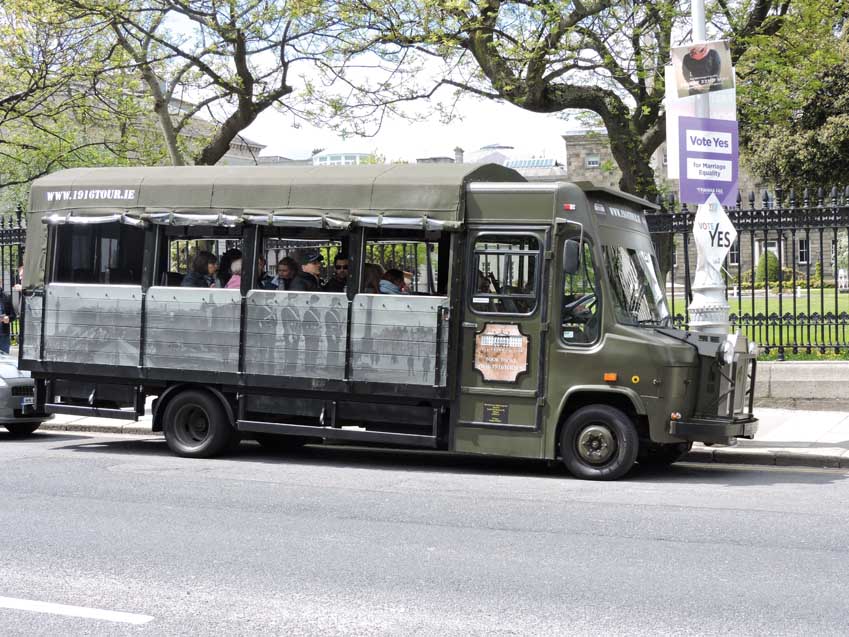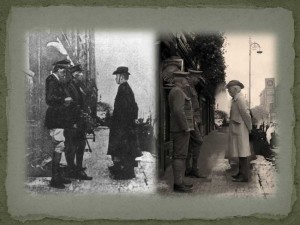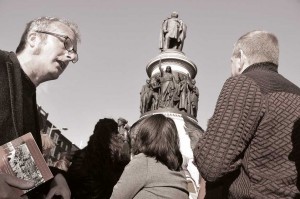1916 tours of Dublin
Published in Issue 2 (March/April 2016), Reviews, Volume 24By Tony Canavan
The fact that the historic streetscape and buildings of Dublin have changed so little over the last century means that the city itself is a kind of museum for the 1916 Rising. Key buildings, squares and streets remain in appearance today much as they did then, a fact that helped in filming RTÉ’s recent drama about the Rising, Rebellion.
1916 Freedom Tour (1916tour.ie)
The unique selling point of this tour is that you travel around Dublin in a military-style truck. One word of warning, though: I did the tour in January and although it was a bright sunny day it was cold inside the truck, as it is authentic to the point of having no windows, leaving the passengers exposed to the elements. So either wrap up well or postpone your tour until the weather improves.
The truck itself is impressive and quite convincing, although it is a converted minibus. All the guides and drivers get into the spirit of the thing by wearing British Army or Irish Volunteer uniforms. Our guide, Bernard, knew his stuff and for over an hour was able to talk non-stop without the aid of notes on the Rising, the events and the people.
The tour begins with an orientation lecture on events leading up to the Rising and a demonstration of the firearms used by the protagonists: the British Army’s Lee Enfield rifle and Webley revolver, and the Volunteers’ German Mauser carbine. Starting on Merrion Square, it follows a route up to St Stephen’s Green, on to Dublin Castle, across the Liffey to O’Connell Street and then south of the Liffey again to take in Mount Street Bridge before returning to Merrion Square.
There are stop-offs along the way at key locations such as the Royal College of Surgeons, Dublin Castle and the GPO. Perhaps one disadvantage of this is that the tour is not chronological but more thematic, as the action at each locale is described and explained. I do not think that anyone was left confused by this approach, as Bernard placed each separate event into the wider context. The twelve people on the tour with me were Irish and so already had a grounding in the history of the Rising. Nevertheless, the tour added depth to everyone’s knowledge and, while concentrating on the military action, also told the stories of the individuals involved, whether famous or not. Overall this was a fascinating, balanced but not dispassionate explanation of and insight into the week which, as Bernard said, shaped today’s Ireland.

The unique selling point of the 1916 Freedom Tour is that you travel around Dublin in a military-style truck.

Top: The 1916 Freedom tour re-enacts Pearse’s surrender to Gen. Lowe.
This is the longest established of the 1916 tours and is for those who prefer a closer view of the city. The tour begins with a history lecture in the International Bar, Wicklow Street, where our guide, Rory, successfully managed to condense 800 years of Irish history into a few minutes. Each person on the tour was also given a leaflet with information on the key organisations involved in the events, such as the IRB and the Irish Volunteers, as well as a reprint of the Proclamation. From there we followed a route that took us to the Bank of Ireland on College Green, Trinity College and across the Rosie Hackett Bridge to the Abbey Theatre before ending up on O’Connell Street.
While there is a lot of walking between stops and Rory battled against the noise of Dublin traffic and the Luas works, this is an enjoyable and informative tour. Its strength lies in placing the 1916 Rising in its historical context, in particular the earlier rebellions against British rule and the Home Rule crisis, while at the same time giving a good account of the events of that fateful week and the roles played by the main protagonists. Like the truck tour, this one also takes in the not-so-famous participants, such as the aforementioned Rosie Hackett or Vol. W.J. Brennan Whitmore.

Lorcan Collins of the 1916 Rebellion Walking Tour, the longest established of the 1916 tours.
Anyone going on this tour should be aware that there is a lot of walking involved (it lasts about two hours), while the Luas works are not conducive to any sense of atmosphere. Despite the introductory lecture, the tour assumes a degree of knowledge of Irish history. Nevertheless, it is well worth going on, both as an introduction to Dublin’s historic centre and as a guide to the 1916 Rising. There was a group of about twenty on the tour that I took, a mix of Irish and foreign visitors, who, like me, seemed to enjoy the experience.
Tony Canavan is editor of Books Ireland.
















